Navigation: Hankeys of Churton > John Hankey > Robert Hankey > Robert Hanky > Thomas Hankey > Henry Hankey >
Sir Joseph Hankey (1696-1769)
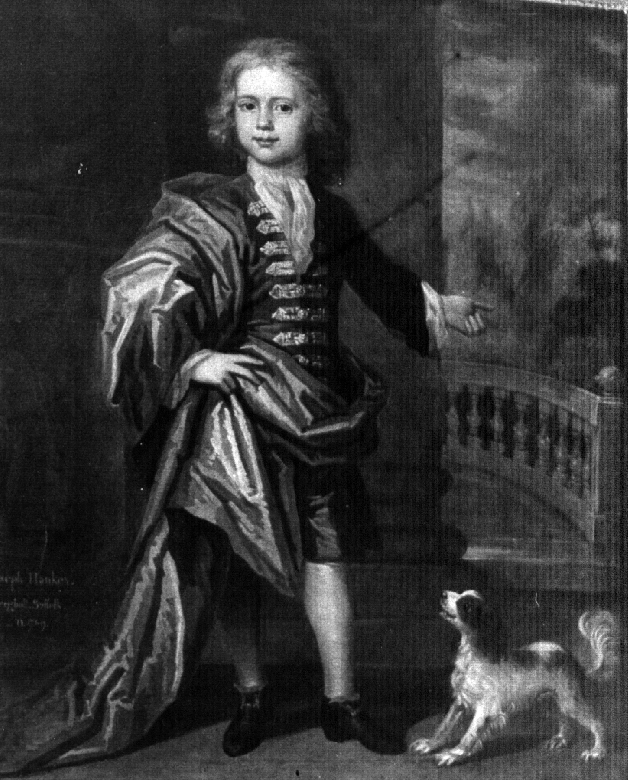
Two portraits of Sir Joseph Hankey were in the drawing-room at Bourton House, Bourton-on-the-Hill, owned by descendants of his grand-daughter Lady Jane Isabella East. One, of a youthful Sir Joseph with his spaniel, was illustrated in Country Life on 30 Mar 1940; the other, of Sir Joseph as a young man in a brown coat and blue cloak, was lot 450 in a sale of the contents by Messrs Nicholas at 4 Albany Courtyard, Piccadilly on 1 Dec 1952.
Other portraits at Bourton House were photographed by Henry Alers Hankey in 1891, including Joseph Chaplin, Sir Henry Hankey and his wife Anne Hankey and Sir Henry Hyde East and his wife Isabella nee Hankey.
The eldest child of Sir Henry Hankey and Anne nee Chaplin, Joseph was born on 25 Sep 1696 and baptised the same day at St Dionis Backchurch. He was educated at Merchant Taylors’ School 1708/9-1711.
Joseph Hankey was married on 9 Jul 1723 at St Paul’s Cathedral to Elizabeth Johnson, daughter of Sir Henry Johnson of The Hermitage, Wapping. Henry Johnson was the owner of a large shipyard at Blackwall, and was buried on 17 Mar 1759 at East Bergholt, the home of his daughter Elizabeth.
Joseph had five sons (none of whom, extraordinarily, had a grandson) and eight daughters, of whom eleven survived:
Anne |
1724- |
m 1744 George Paul |
Elizabeth Ellen |
1725-1798 |
m 1746 Thomas Tyndall (HM Procurator General; Proctor of Doctors Commons; d 1766) issue |
Joseph Chaplin |
1727-1773 |
m 1754 Catherine Gale (1738-1805) - see below |
Mary |
1729-1794 |
m 1758 James Clarke, dry salter, of Garlick Hill |
1730-1782 |
d unm |
|
Sarah |
1733-1760 |
d unm |
Mercy |
1733-1752 |
d unm |
Martha |
1735-1772 |
d unm |
Margaret (Peggy) |
1736-1765 |
m 1758 John Spooner of Westminster |
Henry |
1737-1761 |
d unm |
1740-1802 |
|
The three eldest children were baptised at Clapham.
Joseph Hankey’s career followed closely that of his father. He was Citizen and Haberdasher (admitted 20 Sep 1728 and Master in 1737), goldsmith and banker, being senior partner of the bank from 1737 to 1769, under the name Sir Joseph Hankey & Co.
He was knighted at Hampton Court on 4 Aug 1737, six months after the death of Sir Henry, and followed him as Alderman for Langbourn Ward 1737-69. Although alderman for 32 years he never served as sheriff or lord mayor. He was rejected at the poll when a candidate for the Shrievalty in 1742, owing to his support of Walpole, and he never came forward again.
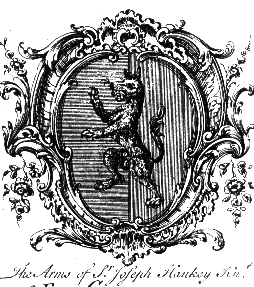
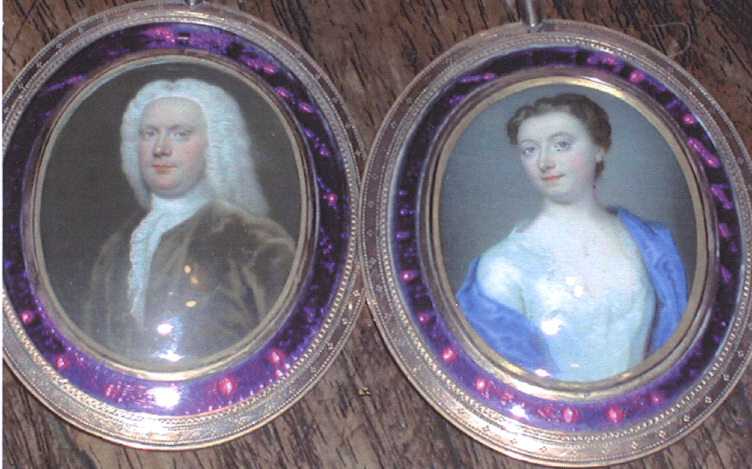
Sir Joseph Hankey and Lady Elizabeth Hankey (nee Johnson)
by C.F.Zinke c.1730
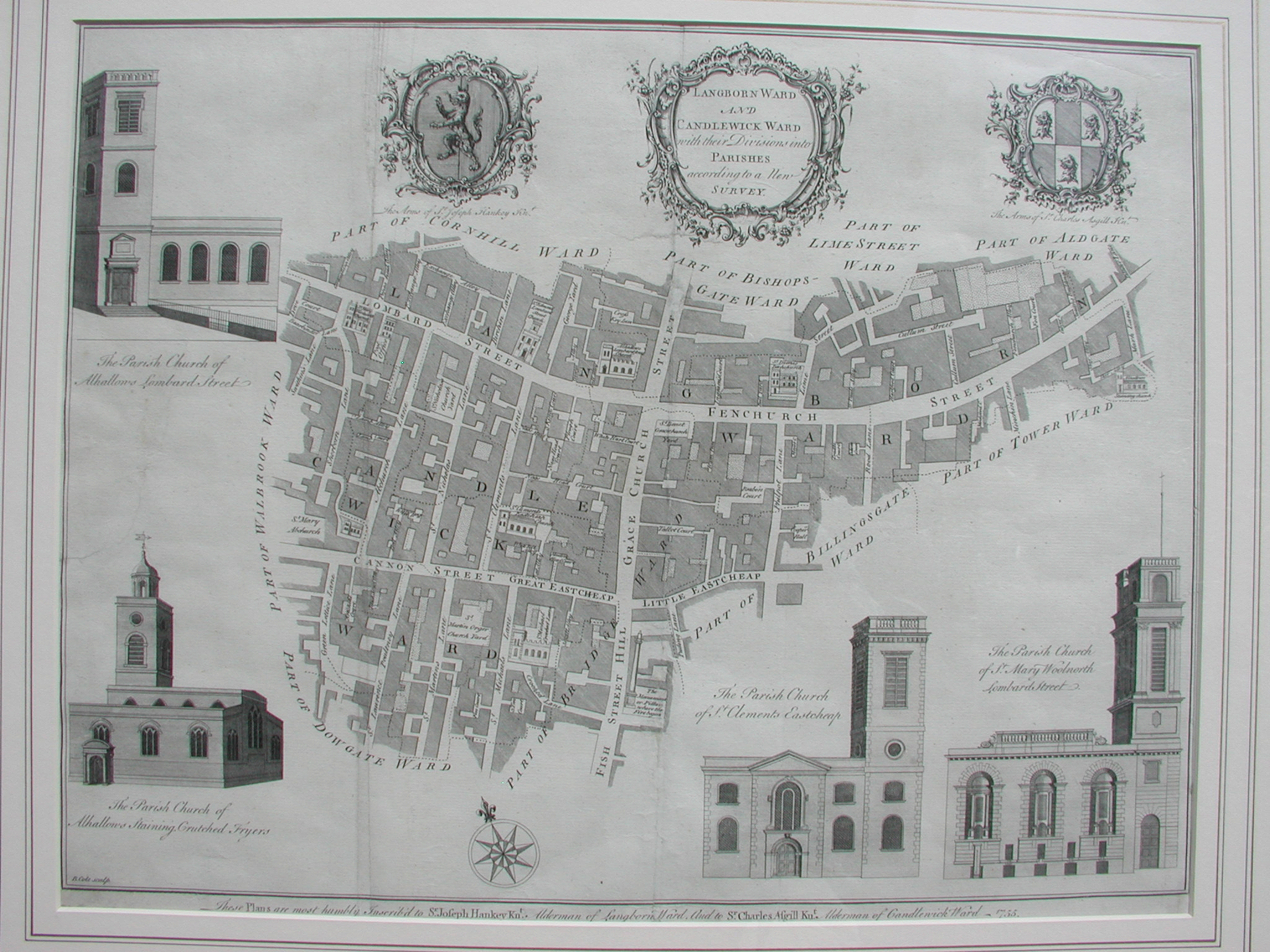
Langbourne Ward in the time of Sir Joseph Hankey
In 1738 Sir Joseph was chosen as one of the Committee of Seven to inspect into the Bye-Laws of the South Sea Company.
He was Colonel of the Blues and President of the Honourable Artillery Company 1754-63.
As President of Christs Hospital 1751-69, and of St Thomas’s Hospital 1751-69, he presided over General Meetings of the Governors as they appointed staff, revised the hospital rules and diet and concerned themselves with fund-raising.
Records of these meetings provide an illuminating account of the running of a charitable hospital in the eighteenth century. High public office as always in those days entailed considerable private expenditure both to finance social functions and to encourage by generous example the offering of voluntary subscriptions. In 1753 Sir Joseph was appointed a life governor of The City of London Lying in Hospital for Married Women.
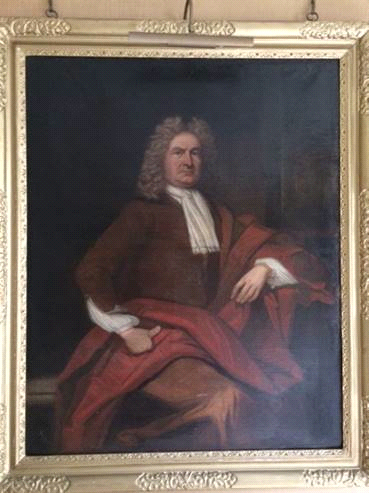
Sir Joseph Hankey
On Sir Henry’s death in 1737 Joseph Hankey inherited the bulk of his maternal grandfather’s estates in Suffolk, including Old Hall, East Bergholt. It seems he used this as his country house, but in old age preferred to live largely at his home in London, above the bank in Fenchurch Street, leaving his eldest son to live at Old Hall with his increasingly large family.
Sir Joseph made his will on 17 Jun 1762 (witnessed by Robert Chamberlain, James Hill and Stephen Hall; executors wife Elizabeth and son Joseph Chaplin Hankey).
He died on 28 Jun 1769 and was buried on 7 Jul at St Dionis Backchurch.
The family were evidently accomplished musicians, as both Sir Joseph and his son Joseph Chaplin Hankey are on record as frequent purchasers of musical scores. Joseph Chaplin Hankey left to his daughter Elizabeth such of his harpsichords as his wife Katharine did not wish to have; and his son Joseph Chaplin Hankey Jr was surrounded in a portrait by sheets of music.
Lady Hankey must have been an accomplished needlewoman, as she was left by her husband ‘the bedquilt, 3 carpets and 7 chairs which are all my wife’s own work’; she died not long after her husband on 14 Sep 1770 at Bath and was buried on 16 Oct at St Dionis Backchurch.
A Musical Family
Through the years, several of the Hankey family were keenly interested in music, and may well have been accomplished musicians themselves:
qSir Joseph Hankey and his son Joseph Chaplin Hankey are on record as frequent purchasers of musical scores.
qIn about 1746, Joseph Gibbs (16991788), organist and composer, published Eight Solos for a Violin with a Thorough Bass for the Harpsichord, with a dedication to Sir Joseph Hankey. (DNB)
qSir Thomas Hankey was an acquaintance of Handel, and attended his concerts in the 1760s.
qJoseph Chaplin Hankey left to his daughter Elizabeth Dobrée such of his harpsichords as his wife Katharine did not wish to have, 1773.
qJoseph Chaplin Hankeys son Joseph Chaplin Hankey Jr was surrounded by sheets of music in his portrait by George Romney, c.1790.
qThe 2nd Viscount Palmerston recorded attending some concerts held by his first cousin Thomas Hankey, including one in 1789 at which there was some very good music.
qKate Hankey was a writer of hymns, including in 1867 the hymn 'Tell me the old, old story'.